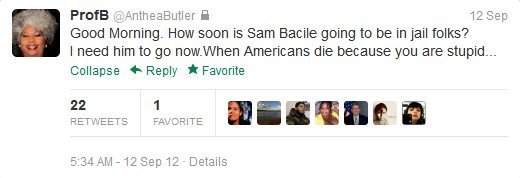Lewis Perdue's Blog, page 14
September 14, 2012
Calls To Censor Anti-Muslim Film Are New McCarthyism
Bacile’s anti-Muslim film was an amateurish piece of trash. So is the drivel we get from the Ku Klux Klan and spinoffs. But America’s First Amendment protects them both.
Bacile certainly is stupid, stupid, stupid. But Professor Butler is wrong, wrong, wrong.
She tried to walk some of that back — or sugarcoat it a little — in this piece published in USA Today but her piece still reflects a fundamental misunderstanding of free speech in America..
Why?
I’ll let the following piece — “The New McCarthyism” – that I wrote for the Los Angeles Times back when I was on the UCLA faculty speak for why she has a seriously flawed view of the First Amendment.
And yes — note the date: 1981. Sadly, in 31 years, nothing has changed among too many of those who benefit from free speech wanting to gag those with whom they disagree. (Click to enlarge.)
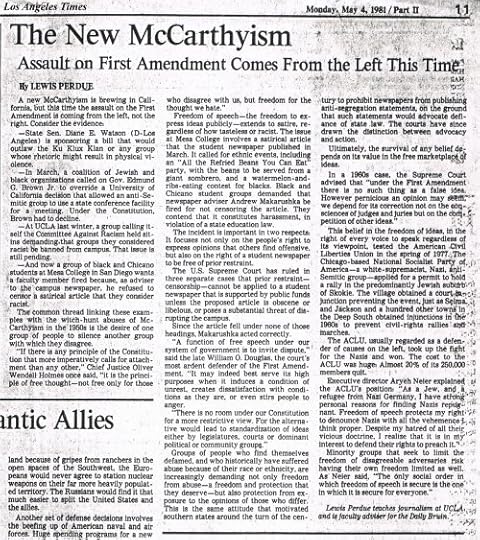
Click image to get a larger one that’s more readable.
Some disgusting things are constitutionally protected because those are the fringes that form the First Amendment boundaries that protect everything else. Remember, birth control, civil rights and breast feeding in public were once illegal and considered disgusting.
The free marketplace of ideas is the appropriate battleground. Fight the battle with the superiority of your own position, not by outlawing those you disagree with or shouting them down to prevent them from speaking.
On a related note, this recent piece of mine may be of interest: What Would The Prophet Protest Today?
Calls To Censor Disgusting Anti-Muslim Film Are Nouveau McCarthyism
Bacile’s anti-Muslim film was an amateurish piece of trash. So is the drivel we get from the Ku Klux Klan and spinoffs. But America’s First Amendment protects them both.
Bacile certainly is stupid, stupid, stupid. But Professor Butler is wrong, wrong, wrong.
She tried to walk some of that back — or sugarcoat it a little — in this piece published in USA Today but her piece still reflects a fundamental misunderstanding of free speech in America..
Why?
I’ll let the following piece — “The New McCarthyism” – that I wrote for the Los Angeles Times back when I was on the UCLA faculty speak for why she has a seriously flawed view of the First Amendment.
And yes — note the date: 1981. Sadly, in 31 years, nothing has changed among too many of those who benefit from free speech wanting to gag those with whom they disagree. (Click to enlarge.)

Click image to get a larger one that’s more readable.
Some disgusting things are constitutionally protected because those are the fringes that form the First Amendment boundaries that protect everything else. Remember, birth control, civil rights and breast feeding in public were once illegal and considered disgusting.
The free marketplace of ideas is the appropriate battleground. Fight the battle with the superiority of your own position, not by outlawing those you disagree with or shouting them down to prevent them from speaking.
On a related note, this recent piece of mine may be of interest: What Would The Prophet Protest Today?
September 13, 2012
What Would The Prophet Protest Today?
Out of my own personal spiritual interest — and in then process of research for faith-driven thrillers like Die By Wire, Perfect Killer and Daughter of God — I have read the Qu’ran from beginning to end at least three times.
If the Prophet Muhammad (peace be upon him) were alive today, his protest would not be over the blather of a crummy video made by religious nut cases.
His protests would be against the slaughter of innocents in Syria, the slums of Cairo, the insanity of zealots in Iran and other countries who pervert Islam for their own personal power games, the oppression of women and other religious faith by the Taliban and most other countries which profess to be Islamic. Yes, the video is worth of protest. But it’s minor compared with the evil and brutality perpetuated by so-called “Islamic republics.”
Today’s “Islamists” are not Muslims. They are prehistoric, irrational throwbacks to a dark, evil, totalitarian xenophobia filled with hatred and bitterness that tolerates nothing beyond their narrow, pathetic, ignorant view of the world.
I’ve also read the Christian and Jewish bibles at least as many times as well as the Book of Mormon, the varied scriptures of the Hindu religion, The Buddha and the writings of the Sikh gurus. Remaining true to those religions and Islam, requires love, charity, aid to the oppressed, a pro-active effort to fight poverty, abuse and a fundamental tolerance of other religions.
Religious extremists of all stripes are evil apostates to their own professed religions regardless of whether their word for the divine creator isl God, Yahweh, Allah or some other word.
September 12, 2012
The Amazon Conundrum
The Amazon Conundrum sounds like the title of one of my thrillers, but it’s about thrillers rather than being one.
See, Amazon has this “Prime” program for Customers and for Kindle books.
For customers, the select program starts with paying $75 per year to get unlimited free shipping. It’s a damned good deal. I’ve been a member since the program began. And for the same $75, my wife and son both get free two-day shipping.
Customers also get to “loan” certain Kindle books to other Kindle users. For free.
That’s where the author … and the conundrum happen.
THE CONUNDRUM FOR AUTHORS
If you’re an author or publisher you can enroll a book in the “KDP Selectprogram. And you can make $2.40 every time a Prime customer loans the book. Given that most of my books are priced at $2.99 or $3.99 and Amazon gets 30% of that, my net looks pretty good.
The conundrum starts when the book is enrolled in the Select program. You have to agree to make your book an Amazon Kindle exclusive for 90 days (renewable if you choose.) Amazon has a pretty good robot that spiders the web and will get on your case if they find it for sale as an ebook somewhere else.
That means no Nook, no Kobo, no Smashwords, no Apple iBookstore.
Barnes and Noble, Smashwords and others cry “foul” at the program.
But you don’t have to be in the Select program to offer your book on Amazon as a Kindle. That seems fair enough.
BUT DON’T YOU LOSE SALES?
In the past nine months I have had six ebooks for sale — one original and five of mine that I got the rights back from their legacy New York publishers.
For half of that nine months, my books were not in the Select program and for sale everywhere. And they have been in the Select program for the other half.
At this point, the money I have made from the $2.40 “loan fee” for books in the Select program is a bit over $1,200 — more than 12 times the total amount of money I have made from all other ebook sales combined.
In essence, I lost more than $1,100 during the months I was not in the Select program.
MIXED EMOTIONS
My head and my bank account have no problems with the Select decision. My heart is another matter.
I would like my books to be for sale everywhere.
And the Chief Technology Officer for Smashwords, Bill Kendrick, is an incredibly talented developer (and hugely intelligent and likeable guy) whom I mentored when he worked for me at winebusiness.com as a college sophomore in the mid-1990s. I’d like to see Bill succeed.
I also like Bill’s boss, Mark Coker who founded Smashwords. I’d like to see them and Smashwords make it big.
I don’t have an answer to this head/heart conundrum.
The solution is for Barnes and Noble and Apple’s iBookstore and everybody else selling ebooks to learn how to compete so they can sell more ebooks. Right now, they spend all their energy kvetching, moaning, groaning and bemoaning Amazon’s dominance.
September 9, 2012
My Tesla Evolution 2: Ion Engine + Atom Smasher = Cosmic Engine
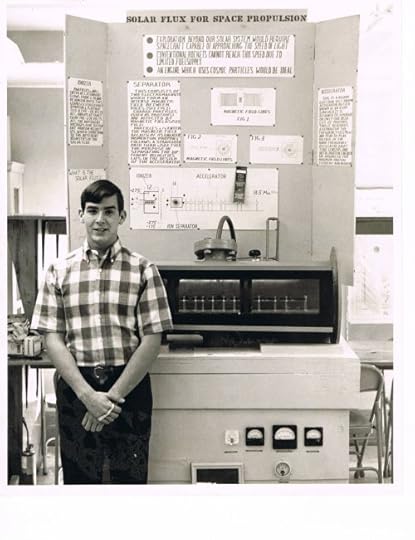
Lewis Perdue The Geek And His Cosmic Engine. The 60 KeV proton accelerator can be seen inside the vacuum chamber. Click image to enlarge and that image to enlarge more.
I never called it a “Cosmic Engine.”
But that’s what the newspapers wound up calling it and the name stuck (see below).
My Papa called it “Project Maybe” and that’s what I liked most. But “cosmic” had a certain ring for the headlines back in the mid-1960s.
And for all you Nikola Tesla fans: note that I got key pieces of equipment from the Westinghouse Corporation. Westinghouse was founded on Tesla’s patents for generating and using alternating current electricity.
No accident. No irony. I knew that before I approached them for help.
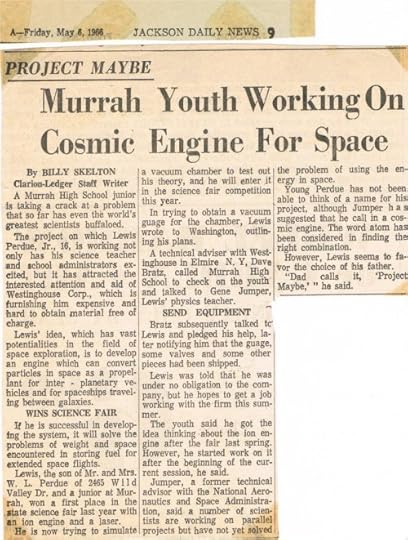
Cosmic Engine – Projec t Maybe. Click to embiggen, and that image to uber-embiggen
At the end of the last post (The Tesla Evolution 1: Coil, Laser, Ion Rocket), I won first prize at the State science fair in 1965 but didn’t make it to the International because I had put too much in the exhibit — both an ion engine and a laser.
But deep-space missions had captured my imagination almost as much as Tesla had.
Hmmm … Tesla, deep-space missions, ion engines … charged particles, high-energy physics, the vacuum of space.
So, I imagined a mission so long that it needed to use the scarce particles in space — the solar flux — for fuel.
GEEK-OUT ALERT! A LITTLE SCIENCE AHEAD
There isn’t much in most part of space. In the unimaginably vast spaces between stars, planets, comets and meteors (and the occasional man-made objects and debris) there’s a lot of nothing. The vacuum out there is almost perfect.
On average, there are 5 or 6 particles in a cubic centimeter of space (something the size of a sugar cube) in the neighborhood of Earth. Less the farther you get from a star like the sun.
Those are mostly protons (hydrogen nuclei stripped of electrons). There will also be alpha particles (a helium nucleus…two protons, two neutrons). Those small bits of something filling the nothing consists of a plasma: a mixture of particles with so much energy that the nuclei of matter can’t hold on to any electrons.
And I imagined that people would want to get wherever that was as fast as possible.
So, I thought, maybe you could use a sort of magnetic to gather those particles and concentrate them.And then feed them into something that would go really, really, really fast: a particle accelerator (aka atom smasher).
FIRST, A VACUUM CHAMBER TO SIMULATE SPACE
First I needed to build a vacuum chamber that could approach the vacuum of space. No easy task.
The quality of a vacuum is measured in torr. Atmospheric pressure on Earth (no vacuum) is 760 torr.
Depending on where you are in outer space, the vacuum is 1/1,000,000 (a micro-torr) to 1/1,000,000,000,000,000 torr.
At the minimum, I had to build a vacuum chamber big enough to hold my entire science fair project at a vacuum of at least 1 micro-torr.
In the end, I managed ten times better than that.
Next, I needed to make something that simulated the solar flux. As it turned out, the ion engine I had built the previous year generated just those kinds of particles. This is what gave me the idea for using the solar flux for fuel.
Okay. Vacuum chamber, check. Ion engine/solar flux, check.
THEN, THE ATOM SMASHER
Why a particle accelerator? Because, heoretically, in the vacuum of space, a craft could eventually approach the velocity of the particles from the engine. In the case of a linear accelerator, those are close to the speed of light…so-called “relativistic” speeds.
Of course, there was no way my protons were going relativistic within the tabletop confines of a science fair exhibit. So I settled for demonstrating that the concept was possible and built a 60-KeV accelerator … translated, that’s a 60,000-electron-volt accelerator.
ZAP! That’s one helluva Tesla fix!
If you want to know a little about how I built it, scroll down to the very bottom of this post.
THE EXPLODING TRANSFORMER AND MY BRUSH WITH THE FCC
The juice behind the accelerator was a radio transmitter (oscillator) powered by a 1,000-watt power supply and putting out about 450 watts of radio frequency waves at 13.5 Megahertz. If you uber-embiggen the image of me and the machine, you’ll see that written as Mcs … back then the standard unit of frequency was still “megacycles per second.”
Anyway, the transmitter and its frequency had several unintended consequences.
First of all, in order to get enough current — 200 amps — to the power supply, I had to basically use all of the power coming into the house. So, I took it upon myself to install a switch that diverted all of the electricity coming into the house so it fed into the power supply. The accelerator took most of that power while the rest of the electricity ran the vacuum pumps and other devices.
This seemed to work just fine except that when the accelerator was on, nobody else in the whole house could use anything electrical.
FIRE IN THE HOLE, EXPLOSION ON THE POLE
After I fired up the accelerator the first few times I did it for short periods of time so that the rest of the family could live in the electrical age.
But one Saturday, everybody was away. So I paid no attention to the time.
Then everything happened at once:
The insulation in one of the power supply components (the bleeder resistor) blew, shorted the whole thing out and exploded. The mercury vapor tubes glowed cherry red and the whole power supply the size of a dishwasher with a 150-pound transformer, danced a crazy jig and buzzed like the Apocalypse.
I ran. I played football those days and was in damn good shape. So I didn’t bother to open the door. I ran through the door into the carport just in time to see flames coming out of the electrical transformer on the pole outside the house.
The transmitter power supply short was so powerful and so fast that it fused (melted the insides) of the house main breaker. The short then hit the transformer. Its own circuit breaker should have prevented damage, but must have malfunctioned.
After some house repairs, the replacement of and improved insulation for the bleeder resistor and an additional circuit breaker for Project Maybe, I got back to work.
THE VISIT FROM THE FCC
A van with antennae on its roof arrived a couple of weeks later. The men inside were from the Federal Communications Commission.
My transmitter/oscillator was screwing up WLBT, Channel 3 – one of the two television stations serving Jackson at that time.
Remember that the particle accelerator operated at 13.5 Megahertz. And there were commercial radio stations operating with about half my output.
The nature of a radio frequency transmitter is such that it also generates harmonics — waves that are multiples of the main frequency. These are lower in strength and can be prevented with better engineering than I had managed so far.
My 13.5 Megahertz transmitter was also broadcasting at 27 Mhz and 54 MHz. Channel 3 operated at 54 MHz.
We never knew about the interference because nobody could watch TV at our house when the accelerator was running.
With information from FCC engineers, I re-built the transmitter, solved that problem and got on to creating more and better problems and finally got the whole thing to the International Science Fair.
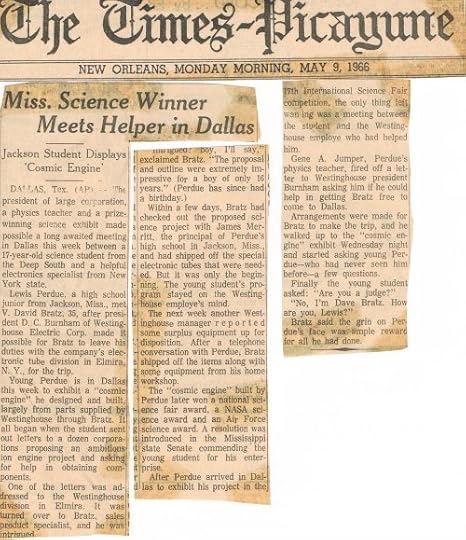
Another short piece about the cosmic engine and the international science fair. Click to enlarge, then click that image to make it even bigger.
BUILDING A PARTICLE ACCELERATOR IN YOUR GARAGE – THE SIMPLIFIED VERSION
Not to go too far into the fine points of building a linear accelerator, suffice it to say that I needed a series of increasingly longer copper tubes hooked up like an antenna to a radio frequency oscillator. Oscillator meaning that radio wave would go from positive to negative at a very strictly controlled frequency.
The tubes needed to be a precise length, in a straight line and be separated by a very precise gap between tubes. The first tube would attract the positively charged hydrogen nucleus (a proton) and accelerate it into the tube.
Inside the tube the radio wave voltage has no effect. But the frequency is timed so that when a proton exits the first tube the voltage turns positive (shoving the proton along) and the second tube is negative, pulling it along.
So, a shove and a pull in the gap, accelerates the proton faster into the second tube. And that tube has to be longer, precisely longer so that the proton enters the next gap at the exact moment to get another shove/pull and into the next tube.
At age 15 when I started this, I had needed to teach myself calculus since it wasn’t offered in school. However, I had not advanced far enough to get the math right for the tube lengths. For that, I had some help from a staff member at the Oak Ridge National Laboratory.
With their corrections to my calculations, I built the accelerator.
September 8, 2012
My Tesla Evolution 1: Coil, Laser, Ion Rocket

Nikola Tesla invented Alternating Current, the electricity that powers the world.
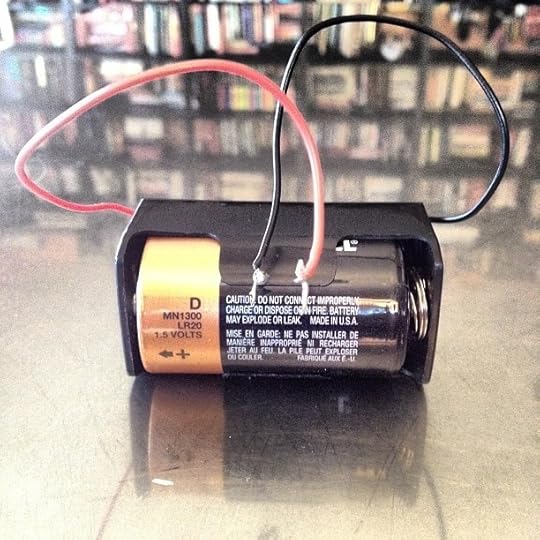
Thomas Edison didn’t invent direct current, but that’s what he used to power his other inventions. It’s hard to distribute and is limited. But still useful for an old technology.
NOW ASK YOURSELF: WHICH ONE OF THESE COULD HAVE SHOCKED A SMALL CHILD INTO BEING A ROCKET SCIENTIST?
It’s impossible to tell whether the butter knife in Tesla’s AC wall socket or my first Tesla coil sent me off on exploring high-energy physics and on my life-long fascination with Tesla’s science and inventions. And motivated me to invent high-voltage rocket engines.
See How Nikola Tesla & A Butter Knife Turned Me Into A Rocket Scientist for more on the butter knife and some of my other death-defying incidents.
THE FIRST TESLA COIL
I think I built my first Tesla coil when I was maybe nine or ten years old. By that time, I had moved my weird science experiments out of my bedroom and into the storage room off the carport. The electricity experiments didn’t thrill my parents. I kept blowing circuit breakers and knocking myself senseless touching various wires and terminals.
My folks tried to deflect my scientific interests. First, there was the chemistry set for Christmas. But before anyone woke up, I had created one giant batch of poisonous chlorine gas that emptied the house. And after I flushed all the beakers of reactants down the drain, it killed all the bacteria in the septic tank which then stopped up. And it never worked well again.
The acetylene gas produced from dropping calcium carbide into water also produced some spectacular results along with removing all the hair from my right arm.
GUNPOWDER AND CHEMICAL ROCKETS
I moved outside for a while, turned to perfecting a formula for gunpowder. I’d surely be arrested by Homeland Security today for the results of those successes. These were the early days of the space program. I do remember getting up at 4 a.m. to watch Alan Shepherd’s Mercury capsule take off. That inspired me to see if I could adapt my gunpowder formula to act as rocket propellent.
Only NASA had more rockets blow up on the launch pad that year. I did have one get 30 or 40 feet off the ground before exploding. That one sent flaming debris everywhere. Three houses down it set an awning on fire. I think that was the first time I came to the attention of the Jackson (Mississippi) Police Department’s juvenile division. It wasn’t the last.
RUSSIANS & FLAMING HOT AIR BALLOONS
The weather balloon trailing a 100-foot roll of aluminum foil that looked enough like Russian missiles to set off Air Force radar and scrambled fighter jets (this was the Cold War, remember?), and the small hot-air balloon made of dry cleaner bags and powered by flaming shoe polish scored two more police inquiries because by then, they knew where to look when weird things happened. Same when I knocked Channel 3 off the air for a bit and blew up the electrical transformer on the pole outside our house.
BIOLOGY: TOO EARLY FOR FRANKENPOOCHES
Anyway, desperate to heep me away from electricity, my folks bought me a whole series of biology experiments. One that came every month. Do weird things with Gibberellins and other plant hormones. Those kits came came one each month. That worked for a while, but unlike chemistry and physics, biology doesn’t go bang. And Gibberellins don’t create the Little Shop of Horrors effect I was really going for. A giant lima bean? Nah.
Also slooooow … boring. It’s an attention span thing. I still suffer from having very little. With my attention span, watching a plant grow was not going to cut it. And this was long before the days when you could engineer genes in the kitchen like you can today.
The idea of turning my cocker spaniel into a FrankenPooch would probably have made me concentrate harder. But DNA was still pretty much a mystery back when I was doing this in 1958 to 1960 or so. DNA’s double-helix structure wasn’t even confirmed until 1958. Genetic engineering had not yet leaped out of from the pages of paperback sci-fi novels.
GIANT TESLA COIL GETS ME KICKED OUT OF HOUSE
So it was that I kept returning to Tesla.
My parents moved me into the storage room after I built my third or fourth Tesla coil (each one bigger than the last). This last one had a secondary coil about four or feet tall. My room was right next to the kitchen. The first time I turned it on, all of the fluorescent lights in the kitchen flickered and the closest ones lit up entirely. The electrical arcs off the top of the secondary seemed to fill my bedroom.
Scared hell out of me.
And I was not allowed to enter it into the seventh grade science fair out of safety concerns.
So, by that point, it was time to move on. And the starting point for that was the Tesla Coil’s ability to make a fluorescent light glow at a distance. And I wanted to know about the glow.
IT WAS ALL ABOUT THE GLOW
Which is when I fell in love with ionized particles, plasmas and other phenomena caused by charged particles.
At high enough voltages, electricity arcs. Lightning’s the biggest display we usually see. But what we really see is the light given off by gas particles that have been excited by the electricity. It’s a quantum thing.
And hard to maintain constantly at atmospheric pressure. But suck some of the air out, and you can get a constant glow. Pump in a gas other than air (Nitrogen, Oxygen, Carbon Dioxide and other elements) and the color changes. Another quantum thing determined by electron orbits.
THE LASER AND THE ION ENGINE
And if you use the right mixture of Neon and Helium and you have the right kind of mirrors and some special glass attached to more glass tubing at just the right angle, you get a laser.
The mirrors and glass were hard to find in Mississippi in 1962 especially since the Ne-He laser had only been invented in 1960.
The first type of semiconductor lasers that are nearly ubiquitous today in everything from DVD drives to lecture pointers were invented in 1962.
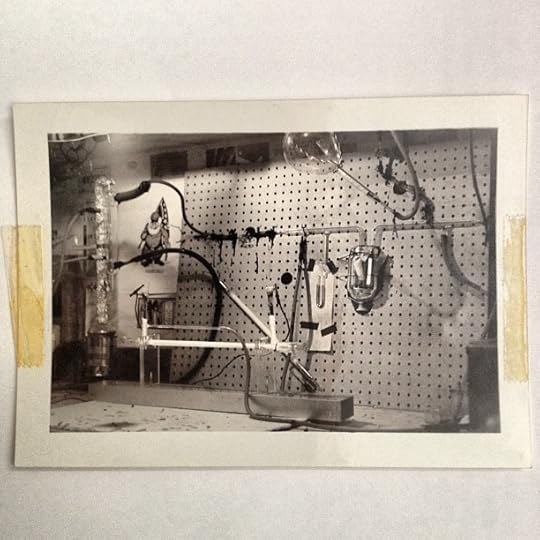
Above is the Neon-Helium gas laser I built in about 1962 or 1963. It’s the horizontal glowing tube lower center to the left. The tall object covered in aluminum foil is a mercury vapor vacuum pump. Click image to enlarge.
But, then, what I really liked was the charged particles, not the laser beam.
And by now, the space program was going great guns, so I built an ion engine. Ion engines don’t have a lot of thrust like chemical rockets and work only in the vacuum of space. Or in a vacuum chamber which was a whole ‘nother technology I had to master in order to test my device.

Above is an ion engine I built. It’s actually the second one and has been modified to send two different velocities of protons. Click image to enlarge.
Ion engines work by using electricity to rip the electrons off a gas (producing a positively charged ion), accelerating the ion to a high speed toward a negative electrode, and neutralizing them with electrons right before they can gather on the negative electron. The suitably neutral particle then zooms into space at high speed, producing thrust.
The beauty of an ion engine is that it uses very little fuel, and given enough time can propel a spacecraft far faster than chemical rockets can. This is why they are great for deep space missions.
So I built one in 1964. It won a ton of awards from NASA.
Thirty-four years later — in 1998 — NASA first used an ion engine to power the Deep Space 1 mission.
I couldn’t decide whether to make the laser or the ion engine my science fair project, so I threw them both in, calling the project, “Space Propulsion And Communications.” I won second place at the state science fair and was told that either one by itself would have taken first, but having them both together was confusing.
Deep space missions powered by electricity and high-energy particles definitely captured my imagination.
Good bye laser, hello cosmic engine.
NEXT: My Tesla Evolution 2: Solar Flux + Atom Smasher = Cosmic Engine
The Tesla Evolution 1: Coil, Laser, Ion Rocket

Nikola Tesla invented Alternating Current, the electricity that powers the world.

Thomas Edison didn’t invent direct current, but that’s what he used to power his other inventions. It’s hard to distribute and is limited. But still useful for an old technology.
NOW ASK YOURSELF: WHICH ONE OF THESE COULD HAVE SHOCKED A SMALL CHILD INTO BEING A ROCKET SCIENTIST?
It’s impossible to tell whether the butter knife in Tesla’s AC wall socket or my first Tesla coil sent me off on exploring high-energy physics and on my life-long fascination with Tesla’s science and inventions. And motivated me to invent high-voltage rocket engines.
See How Nikola Tesla & A Butter Knife Turned Me Into A Rocket Scientist for more on the butter knife and some of my other death-defying incidents.
THE FIRST TESLA COIL
I think I built my first Tesla coil when I was maybe nine or ten years old. By that time, I had moved my weird science experiments out of my bedroom and into the storage room off the carport. The electricity experiments didn’t thrill my parents. I kept blowing circuit breakers and knocking myself senseless touching various wires and terminals.
My folks tried to deflect my scientific interests. First, there was the chemistry set for Christmas. But before anyone woke up, I had created one giant batch of poisonous chlorine gas that emptied the house. And after I flushed all the beakers of reactants down the drain, it killed all the bacteria in the septic tank which then stopped up. And it never worked well again.
The acetylene gas produced from dropping calcium carbide into water also produced some spectacular results along with removing all the hair from my right arm.
GUNPOWDER AND CHEMICAL ROCKETS
I moved outside for a while, turned to perfecting a formula for gunpowder. I’d surely be arrested by Homeland Security today for the results of those successes. These were the early days of the space program. I do remember getting up at 4 a.m. to watch Alan Shepherd’s Mercury capsule take off. That inspired me to see if I could adapt my gunpowder formula to act as rocket propellent.
Only NASA had more rockets blow up on the launch pad that year. I did have one get 30 or 40 feet off the ground before exploding. That one sent flaming debris everywhere. Three houses down it set an awning on fire. I think that was the first time I came to the attention of the Jackson (Mississippi) Police Department’s juvenile division. It wasn’t the last.
RUSSIANS & FLAMING HOT AIR BALLOONS
The weather balloon trailing a 100-foot roll of aluminum foil that looked enough like Russian missiles to set off Air Force radar and scrambled fighter jets (this was the Cold War, remember?), and the small hot-air balloon made of dry cleaner bags and powered by flaming shoe polish scored two more police inquiries because by then, they knew where to look when weird things happened. Same when I knocked Channel 3 off the air for a bit and blew up the electrical transformer on the pole outside our house.
BIOLOGY: TOO EARLY FOR FRANKENPOOCHES
Anyway, desperate to heep me away from electricity, my folks bought me a whole series of biology experiments. One that came every month. Do weird things with Gibberellins and other plant hormones. Those kits came came one each month. That worked for a while, but unlike chemistry and physics, biology doesn’t go bang. And Gibberellins don’t create the Little Shop of Horrors effect I was really going for. A giant lima bean? Nah.
Also slooooow … boring. It’s an attention span thing. I still suffer from having very little. With my attention span, watching a plant grow was not going to cut it. And this was long before the days when you could engineer genes in the kitchen like you can today.
The idea of turning my cocker spaniel into a FrankenPooch would probably have made me concentrate harder. But DNA was still pretty much a mystery back when I was doing this in 1958 to 1960 or so. DNA’s double-helix structure wasn’t even confirmed until 1958. Genetic engineering had not yet leaped out of from the pages of paperback sci-fi novels.
GIANT TESLA COIL GETS ME KICKED OUT OF HOUSE
So it was that I kept returning to Tesla.
My parents moved me into the storage room after I built my third or fourth Tesla coil (each one bigger than the last). This last one had a secondary coil about four or feet tall. My room was right next to the kitchen. The first time I turned it on, all of the fluorescent lights in the kitchen flickered and the closest ones lit up entirely. The electrical arcs off the top of the secondary seemed to fill my bedroom.
Scared hell out of me.
And I was not allowed to enter it into the seventh grade science fair out of safety concerns.
So, by that point, it was time to move on. And the starting point for that was the Tesla Coil’s ability to make a fluorescent light glow at a distance. And I wanted to know about the glow.
IT WAS ALL ABOUT THE GLOW
Which is when I fell in love with ionized particles, plasmas and other phenomena caused by charged particles.
At high enough voltages, electricity arcs. Lightning’s the biggest display we usually see. But what we really see is the light given off by gas particles that have been excited by the electricity. It’s a quantum thing.
And hard to maintain constantly at atmospheric pressure. But suck some of the air out, and you can get a constant glow. Pump in a gas other than air (Nitrogen, Oxygen, Carbon Dioxide and other elements) and the color changes. Another quantum thing determined by electron orbits.
THE LASER AND THE ION ENGINE
And if you use the right mixture of Neon and Helium and you have the right kind of mirrors and some special glass attached to more glass tubing at just the right angle, you get a laser.
The mirrors and glass were hard to find in Mississippi in 1962 especially since the Ne-He laser had only been invented in 1960.
The first type of semiconductor lasers that are nearly ubiquitous today in everything from DVD drives to lecture pointers were invented in 1962.

Above is the Neon-Helium gas laser I built in about 1962 or 1963. It’s the horizontal glowing tube lower center to the left. The tall object covered in aluminum foil is a mercury vapor vacuum pump. Click image to enlarge.
But, then, what I really liked was the charged particles, not the laser beam.
And by now, the space program was going great guns, so I built an ion engine. Ion engines don’t have a lot of thrust like chemical rockets and work only in the vacuum of space. Or in a vacuum chamber which was a whole ‘nother technology I had to master in order to test my device.

Above is an ion engine I built. It’s actually the second one and has been modified to send two different velocities of protons. Click image to enlarge.
Ion engines work by using electricity to rip the electrons off a gas (producing a positively charged ion), accelerating the ion to a high speed toward a negative electrode, and neutralizing them with electrons right before they can gather on the negative electron. The suitably neutral particle then zooms into space at high speed, producing thrust.
The beauty of an ion engine is that it uses very little fuel, and given enough time can propel a spacecraft far faster than chemical rockets can. This is why they are great for deep space missions.
So I built one in 1964. It won a ton of awards from NASA.
Thirty-four years later — in 1998 — NASA first used an ion engine to power the Deep Space 1 mission.
I couldn’t decide whether to make the laser or the ion engine my science fair project, so I threw them both in, calling the project, “Space Propulsion And Communications.” I won second place at the state science fair and was told that either one by itself would have taken first, but having them both together was confusing.
Deep space missions powered by electricity and high-energy particles definitely captured my imagination.
Good bye laser, hello cosmic engine.
NEXT: The Tesla Evolution 2: Solar Flux + Atom Smasher = Cosmic Engine
September 7, 2012
How Nikola Tesla & A Butter Knife Turned Me Into A Rocket Scientist
The Kindle edition of my Cold War thriller, The Tesla Bequest, was published today. Click here for more.
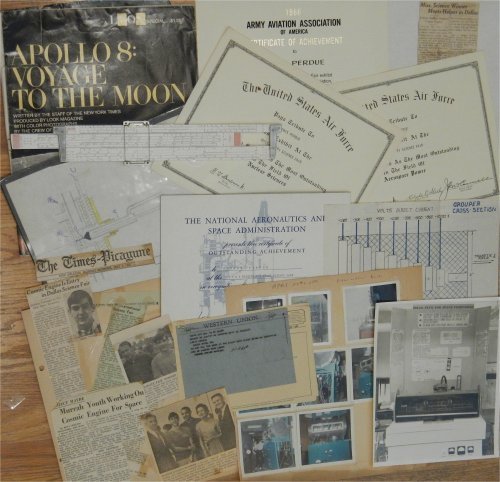
This collage illustrates my ion rocket engine and particle accelerator that used the solar flux for space propulsion. Photos from 1966.
(Click image to enlarge … and click that large one to make it even bigger)
Nikola Tesla turned me into a rocket scientist. Or it might have been a butter knife that did it.
I think both.
IN THE BEGINNING WAS THE BUTTER KNIFE
The butter knife came first, but I don’t remember any of it.
However, the story as widely repeated in the family, has me as a very young child exploring my world with a silver-bladed, pearl-handled butter knife at my grandmother’s house in Itta Bena, in the Mississippi Delta. Since I was up and walking at 8 months, it was hard to keep an eye on me.
So, it wasn’t much of a surprise that while the adults lingered at the dining room table, I wandered off. Not to be heard of until the lights went out. Right after I stuck the butter knife in the electrical socket.
I am told I was found a good distance away from the charred socket, still holding on to the blackened remains of the butter knife. Much of the blade had melted. The insulated mother-of-pearl handle was credited with offering up an enthusiastic but less-than-lethal jolt.
From that point on, I got blamed for most local electrical disturbances.
And many of them were, indeed, my fault. And Nikola Tesla’s for inspiring a series of high-voltage, extreme weird science experiments that culminated in a”cosmic engine” (see collage) that demonstrated the use of the solar flux for space propulsion and won a ton of prizes, awards and scholarships from NASA, the Air Force and others.
THE TESLA INSPIRATION
As hard as my parents tried to keep me away from electricity, it was impossible. Not long after the butter knife came Christmas. Like most kids, the tree lights fascinated me. I do remember wondering why they went on and off. So I unscrewed one. It went out. Didn’t seem to be anything in the socket. So I stuck my finger in.
The tree lights went out. My lights went on.
As I got older, I kept at electrical things. Rewired flashlights. Learned where not to stick my fingers. Took radios apart (this was the vacuum tube era). Then I built radios. Got fascinated at how various tubes glowed in different ways.
And while shortwave and Ham radio were the Internet of the 1950s and 60s, I was more interested in the electricity in the machine than the communication the electrons produced.
So, while using the Google of the late 1950s (called a library) to research the funny ways vacuum tubes glowed, I stumbled across instructions on how to make a Tesla coil.
HOW I ACCIDENTALLY INVENTED THE HAARP PROGRAM.
I also stumbled into the Nikola Tesla rabbit hole and followed the other-worldly tunnels into a fascination, a compulsion, and a motivation to study the science of high energy physics.
That prompted me to build things that sparked, arced, shorted out entire neighborhoods, blanked out a television broadcast station, scrambled Air Force jets who thought they were chasing Russian missiles or bombers.
And won prizes at the 1966 international science fair and achieved a degree of scientific acclaim.
Then I wrote a “what-if?” Tesla/Cold War thriller — The Tesla Bequest — that was first published by Pinnacle Books in 1984 and inadvertently invented the HAARP project and launched a million conspiracy theories.
Life’s not been the same. Thank you Nikola.
NEXT: The Tesla Evolution 1: Coil, Laser, Ion Rocket Engine (I hope to have this written, and a link to it love, on Saturday, 9/8.)
August 23, 2012
Think Like An Actor, Write Like God
Molly Ringwald wrote a very interesting piece recently for the New York Times: Act Like a Writer.
“The appeal of diving into a character has always been the back story: everything that my character has been through up to the point when the audience first encounters her. I have eagerly invented intricate histories that I shared with no one — except during an occasional late night boozy discussion with other like-minded and obsessive actors.”
Yes! Yes! Yes!
And more yes! when she writes about needing to “find the humanity in the stereotypes that we had been assigned.”
No argument.
One of my primal joys of writing a book is getting into the head of the characters.
Finding out what they feel like, what floats their various boats … no matter how twisted or evil they might be (altho that can be a psychologically draining experience) … for, only when you have become the character, can you credibly write about what they will do, how they will react in any given circumstance.
That’s like method acting.
So, rather than act like a writer, I think that a writer must write like an actor.
And be the writer. Because Ringwald’s article goes on to point out the limitations of being the actor:
“I could control only my character. The other characters, and the world in which they interacted, were untouchable. Even my influence on my character, I came to understand, was fundamentally limited; ultimately the character’s destiny was determined by the writer — or, in certain instances, by the “auteur” director.
“There is that moment when you realize the limitations of what you are doing and it shines a light on other creative possibilities. Before I acted in film, I had grown up in the theater and always considered it the apogee of art.”
So, think like an actor, write like God. Omniscience and omnipotence rock!
August 22, 2012
S/he Who Doesn’t Dare Never Wins
We have no more giants in politics. Greatness has fled the national stage. We are a country of excuses and naysayers who ask “why?” instead of “why not?”
“Who dares, wins” is not just an SAS motto, it’s a philosophy increasingly lost among the 50% of Americans who get government benefits and pay no taxes. Yeah, sometimes s/he who dares gets mangled. But s/he who doesn’t dare never wins.
This, from Theodore Roosevelt, rings true with me.
“It is not the critic who counts, not the one who points out how the strong man stumbled or how the doer of deeds might have done better.
“The credit belongs to the man who is actually in the arena, whose face is marred with sweat and dust and blood; who strives valiantly;
“Who errs and comes short again and again; who knows the great enthusiasms, the great devotions, and spends himself in a worthy cause;
“Who, if he wins, knows the triumph of high achievement;
“And who, if he fails, at least fails while daring greatly, so that his place shall never be with those cold and timid souls who know neither victory or defeat.”
And cut the old bullmoose a little slack. If he wrote this today, he’d no doubt acknowledge that today’s women can kick ass and take names.

